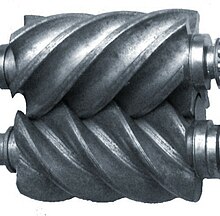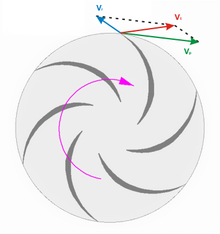Heat machine
A thermal engine is a set of mechanical elements that allows the exchange of energy, usually through an axis, through the variation of energy of a fluid that varies its density significantly when passing through the machine. It is a fluid machine in which the specific volume of the fluid varies to such an extent that the mechanical effects and the thermal effects are interdependent.
In a thermal machine, the compressibility of the fluid is not negligible and it is necessary to consider its influence on the transformation of energy.
Heat machine and heat engine
At first, a thermal machine could be defined as a device, equipment or an installation destined to the production of work by virtue of a caloric input. Although in some definitions the terms «motor heat engine» and «heat engine» are identified as synonymous, in others both concepts are differentiated. By differentiating them, it is considered that a heat engine is a set of mechanical elements that allows mechanical energy to be obtained from the thermal energy obtained through a combustion reaction or a nuclear reaction. A thermal engine has what is necessary to obtain thermal energy, while a motor thermal machine needs thermal energy to function, through a fluid that has more energy at the entrance than at the exit.
Classification
Depending on the direction of energy transfer
Thermal machines can be classified, according to the direction of energy transfer, in:
- Motor thermal machines, in which the energy of the fluid decreases as it passes through the machine, obtaining mechanical energy in the axis.
- Thermal generating machines, in which the energy of the fluid increases by crossing the machine, requiring mechanical energy in the axis.
According to the principle of operation
Based on the principle of operation, heat machines are classified into:
- Volumetric machines or positive displacement machines, whose operation is based on mechanical and hydrostatic principles, so that the fluid at some point is contained in a volume limited by the elements of the machine. In this type of machines the flow is pulsatory. They are divided into two types according to the movement of the propulsor organ: alternatives, whose movement is rectilinear; and rotative, whose movement is circular.
- Turbomachines, whose operation is based on the exchange of amount of movement between the fluid and a surround. In these machines the flow is continuous.
Taking the above into account, we can classify heat engines as shown in the following table.
| Motors | Volumetrics | Alternatives | Steam machine |
| Rotative | Motor Wankel | ||
| Turbomachines | Turbine | ||
| Generators | Volumetrics | Alternatives | piston compressor |
| Rotative | Rotary compressor | ||
| Turbomachines | Turbocompressor | ||
Energy balance in a heat engine
An open system is one that exchanges matter and energy with its surroundings. Applying the first law of thermodynamics to an open system, the increase in energy of the system in a time interval is expressed as:
Δ Δ Esistema=Q+W+␡ ␡ inmin(h+12V2+gz)in− − ␡ ␡ orutmorut(h+12V2+gz)orut{displaystyle Delta E_{system}=Q+W+sum _{in}m_{in}(h+{frac {1}{2}}}V^{2}+gz)_{in}-sum _{out}m_{out}(h+{frac {1}{2}}V^{2}+gz)_{out}}}}}}}
where;
- Q is the heat delivered to the system. It will be negative when the heat is delivered by the system.
- W is the work delivered to the system, in the form of mechanical work and pressure energy. It will be negative when the heat is delivered by the system.
- The subscript in represents the matter that enters the system.
- The subscript out represents the matter that comes out of the system.
- h is the entalpia per mass unit of the flow
- V2/2 is kinetic energy per mass unit of the flow.
- gz is the potential energy per mass unit of the flow
Making the derivative of the previous expression with respect to time, we obtain:
dEsistemadt=Q! ! +W! ! +m! ! in(h+12V2+gz)in− − m! ! orut(h+12V2+gz)orut{displaystyle {frac {dE_{system}{dt}}={dot {Q}+{dot {W}}}+{dot {m}_{in}}(h+{frac}{2}{2}{2}{2}}{in}-{in}-{dot {m} {m}{out}}{x1}{2}{2}{2}{x1⁄2}{2}}}}{x1⁄2}}}{x1}{x1⁄2}
It must be taken into account that in generating machines, this expression can appear with the sign of W changed, so that the work delivered by the machine is expressed and thus W be positive.
Simplifications
The equation that expresses the energy balance can be simplified in the following cases:
- Rest system
When the system is at rest, as in stationary machines, the variations of potential energy and kinetic energy will be zero.
- dEsistemadt=dUdt+Ecdt+Epdt=dUdt{displaystyle {frac {dE_{system}}{dt}}={frac {dU}{d}{dt}}{frac {E_{c}{dt}}}}}}{frac {E_{p}}}}{{dt}}}}{{{frac}{d}}}}}}}}}}}}}}}}}}}{
- Permanent system
When the machine works in steady state, the amounts of mass and energy that enter are equal to those that come out, otherwise those amounts would vary within the system.
- m! ! =m! ! in=m! ! orut{displaystyle {dot {m}}={dot {m}}_{in}={dot {m}}{out}}}
- dEsistemadt=0{displaystyle {frac {dE_{system}{dt}}=0}
- Variation of potential despicable energy
In most heat engines, the difference in potential energy of the outgoing flow compared to the incoming flow is insignificant compared to the other terms associated with the flow energy.
- Δ Δ (gz).. Δ Δ (h+12V2)⇒ ⇒ Δ Δ (gz)≈ ≈ 0{displaystyle Delta (gz)ll Delta left(h+{frac {1}{2}{2}V^{2}right)Rightarrow Delta (gz)approx 0}
- Adiabatic systems
In most heat engines, heat transfer is negligible compared to other energy exchanges. Taking into account the heat transfer by conduction and convection:
- Q! ! =dQdt=U⋅ ⋅ A⋅ ⋅ Δ Δ TLM≈ ≈ 0{displaystyle {dot {Q}}={frac {dQ}{dt}}}=Ucdot Acdot Delta T_{LM}approx 0}
where Q It's the heat exchanged, U is the global coefficient of heat transfer, A is the surface of the system and Δ Δ TLM{displaystyle Delta T_{LM}} is the difference of logarithmic mean temperatures, it can be considered that the system is adiabatic when one of the following conditions is given:
- The external surface of the system is thermally insulated.
- The external surface of the system is very small.
- The temperature difference between the flow and the system environment is small.
- The fluid passes through the machine so fast that there is hardly time to make the heat transfer per mass unit significant.
Heat machine in steady state with negligible potential energy variation
In a thermal machine that works in a permanent regime in which the variation of potential energy is neglected, the expression the first law of thermodynamics can be expressed as
W! ! =m! ! [chuckles](h+V22)orut− − (h+V22)in]=m! ! [chuckles]h0orut− − h0in]{displaystyle {dot {W}}={dot {m}}[(h+{frac {V^{2}{2}}{2}}}})_{out}-(h+{frac {V^{2}}}{2}}}{in}]}{dot {m}}[h_{0out}-h_{0in}]}]}}}}}
where h0 is the stopping enthalpy.
In the thermodynamic cycles associated with the steam turbine, the specific kinetic energy can be considered negligible compared to the enthalpy, resulting
W! ! =m! ! [chuckles](h+V22)orut− − (h+V22)in]=m! ! [chuckles]h0orut− − h0in]{displaystyle {dot {W}}={dot {m}}[(h+{frac {V^{2}{2}}{2}}}})_{out}-(h+{frac {V^{2}}}{2}}}{in}]}{dot {m}}[h_{0out}-h_{0in}]}]}}}}}
Performance
To calculate the performance, the energy obtained is related, either in the form of an increase in energy in the fluid or in the form of mechanical energy supplied by the machine, between the maximum energy that could be obtained in the boundary conditions.
Performance of a motor heat engine
- Internal performance
The maximum specific work that can be obtained in the expansion of a fluid is defined by the enthalpy difference between the fluid at the inlet and the isentropic conditions at the outlet pressure. Instead the actual work is less than this due to the increase in entropy.
- MIL MIL i=W! ! iW! ! max=m! ! (h01− − h02)m! ! (h01− − h02s)=h01− − h02h01− − h02s{displaystyle eta _{i}={frac {{dot {w}}_{i}{dot {W}}}_{max}}}}={frac {{dot {m}}}{c}{c}{cH}{cHFFFF}{c}{c}{cHFF}}{cHFF}{cHFF}}}{cHFF}}}{cHFF}{cHFF}{cHFF}{cHFF}}}{cHFFFFFFFFFFFFFF}}}}}}{cHFF}}{cHFF}{cHFFFFFFFFFFFFFF}}}}}}}}{cHFF}{cHFF}{cHFFFF}{cHFF}{cHFF}{cHFFFFFF}{cHFF}{cH}}{cHFFFF}}}{cH
- Mechanical performance
Mechanical performance is the relationship between effective power (()W! ! e{displaystyle {dot {W}}_{e}}), which is the power obtained in the axis, and the internal power ((W! ! i{displaystyle {dot {W}}_{i}}), which is the variation per unit of time of the fluid energy. The actual power results from subtracting the power indicated less the power of mechanical losses (W! ! pm{displaystyle {dot {W}_{pm}}), which is dissipated the friction of mechanical elements (cojinets, retainers, etc.) and in the drive of auxiliary elements (oil pump, fans, etc.)
- W! ! e=W! ! i− − W! ! pm{displaystyle {{dot {W}}_{e}}={{{{dot {W}}}{dot {W}}}{p}m}}}
- MIL MIL m=W! ! eW! ! i=W! ! i− − W! ! pmW! ! i=1− − W! ! pmW! ! i{displaystyle eta _{m}={frac {{dot {w}}{dot}{dot {w}}{w}}}}{frac {{dot {w}}}}{d}{d}{d}{d}}{d}{d}{d}{d}}{d}{d}{d}{d}}}{d}}{d}{d}}{d}{d}{d}{d}}{d}{d}}}{d}}{d}{d}{d}{d}}{d}}}{d}{d}}}}}}{d}{d}{d}{d}{d}{d}}{d}{d}{d}{d}{d}{d}{d}{d}}}}}}{
- Iso-entropic performance
The isentropic efficiency relates the power obtained in the axis with the maximum power of the isentropic process under the same boundary conditions.
- MIL MIL s=W! ! eW! ! max=W! ! eh01− − h02s{displaystyle eta _{s}={frac {{dot {W}}_{e}{dot {W}}}_{max}}}}}{frac {{dot {W}}}}}{h_{01}-h_{02s}}}}}}}
Efficiency of a generating thermal machine
- Internal performance
The minimum specific work to compress a fluid from a thermal state to a given pressure is equal to the enthalpy jump of the corresponding isentropic process, so that a real process will present a greater difference in enthalpies of the fluid between the inlet and outlet.
- MIL MIL i=W! ! minW! ! i=m! ! (h02s− − h01)m! ! (h02− − h01)=h02s− − h01h02− − h01{displaystyle eta _{i}={frac {{dot {w}}_{min}}{dot {w}}{w}}}}}{frac {{dot {m}}}{c}{c}{cH}{cHFFFF}{c}{c}{cHFF}}{cHFF}{cHFF}}}{cHFF}{cHFF}{cHFF}}}{cHFF}}{cHFF}}{cH}{cHFF}{cHFF}}{cHFF}}}{cHFF}{cHFFFFFFFFFFFF}}}}}}}}{cHFF}{cHFF}}{cHFF}{cHFF}{cH00}{cHFF}{cH}}}{cHFFFF}{cHFF}{cHFF}{
- Mechanical performance
Mechanical performance is the relationship between effective power (()W! ! e{displaystyle {dot {W}}_{e}}), which is the power obtained in the axis, and the internal power ((W! ! i{displaystyle {dot {W}}_{i}}), which is the variation per unit of time of the fluid energy. The actual power results from subtracting the power indicated less the power of mechanical losses (W! ! pm{displaystyle {dot {W}_{pm}}), which is dissipated the friction of mechanical elements (cojinets, retainers, etc.) and in the drive of auxiliary elements (oil pump, fans, etc.)
- W! ! e=W! ! i+W! ! pm{displaystyle {{dot {W}}_{e}}={{{{dot {W}}}{dot {W}}}}{{dot {W}}}}}}
- MIL MIL m=W! ! iW! ! e=W! ! e− − W! ! pmW! ! e=1− − W! ! pmW! ! e{displaystyle eta _{m}={frac {{dot {w}}{dot}{dot {w}}}{w}}}{frac {{dot {w}}}}{d}{d}{d}}{d}{d}{d}{d}{d}}{d}{d}{d}{d}}}{d}}{d}{d}}{d}{d}{d}}{d}}{d}}{d}{d}}}{d}{d}{d}{d}{d}}}{d}{d}}}}}}{d}{d}{d}{d}{d}{d}{d}{d}}{d}{d}{d}}{d}{d}{d}}}}}{
- Iso-entropic performance
The isentropic efficiency relates the minimum power of the isentropic process in the same boundary conditions with the power supplied in the axis.
- MIL MIL s=W! ! minW! ! e=m! ! (h01s− − h01)W! ! e{displaystyle eta _{s}={frac {{dot {W}}_{min}}{{dot {W}}}_{e}}}}}{frac {{dot {m}}}}}(h_{01s}-h_{01}}}{{{{{dot {W}}}}}}}}{{{{
The strength of heat energy varies with the material used to emit the heat energy
Contenido relacionado
Horizontal parallax
Units of mass
Faraday cage













![{displaystyle {dot {W}}={dot {m}}[(h+{frac {V^{2}}{2}})_{out}-(h+{frac {V^{2}}{2}})_{in}]={dot {m}}[h_{0out}-h_{0in}]}](https://wikimedia.org/api/rest_v1/media/math/render/svg/3de43dd1f627539c3e1bc008db3104c2b0be8578)











